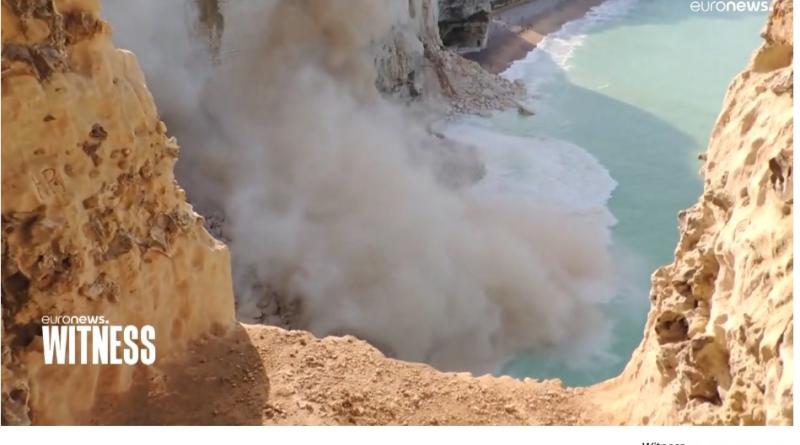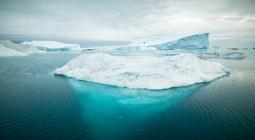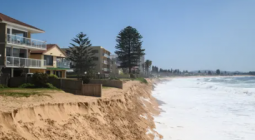The French and German coastal regions on the climate change frontline

Climate change is eating away Europe’s coastlines. In the German Wadden Sea, holms and islands are under threat – and in French Normandy giant cliffs crumble more and more frequently. Erosion is speeding up. Sea levels are rising. Climate change is getting serious.
Destination: the chalk cliffs of Etretat
Too much wind, waves too high – captain Stéphane Dodivers had some doubts about confirming this trip. But finally, let’s go. Destination: the chalk cliffs of Etretat.
In spite of the strong currents, the French skipper of La Mer Pour Tous risks the passage.
Here in the Normandy region, rocks are cracking down. We travel to those places where global warming is visible, where climate change has already started.
How long can the Normandy chalk cliffs withstand climate change? Brutal changes in temperatures, extreme rainfall and the waves of rising sea waters are digging stronger and higher into the cliffs’ basements.
“The changes here around are huge. We moved from around three major cliff crash events per year to now a dozen crashes,” says Dodivers. “And we are just talking about this 30km part of the Normandy coastline. Personally, I feel very sad about this, because it means that the cliffs will have another face and, for certain in a few decades the arcs of Etretat won't exist any longer”.
Global warming is a lot to blame: we have high temperatures and a lot of rainfall. The abundant water infiltrates the cliffs from top-down. This water intrusion triggers the breakdown of the chalk.
Village mayor Raphaël Lesueur takes me downhill to the famous pebble beach of “Tilleul”. He banned access to the risk zone and chases off imprudent tourists.
We move on to see the site of a second crash, even bigger in size compared to this first one here. How do you explain this event?
“I think it’s the storms, the rain,” says Lesueur. “But it’s true, we should ask to what extent climate change is involved. It is a real concern because if it’s happening here, it risks happening also to other cliffs in the region. Our coastline is going to change. It makes you feel sad”.
Criel-sur-mer is known for its houses aligned at the edge of the cliff. Thick pebble layers protect one part of the settlement from the waves, but just a few metres further the foot of the cliffs lays naked. Erosion speeds up not just because of climate change, the mayor of Criel underlines, there are further reasons, man-made too.
“The construction of piers and groynes all along the coast has slowed down this sedimentary transit,” says Alain Trouessin. “This has the effect that the feet of the cliff in places are bare, so the waves attack the foot of the cliff directly.”
“The projections give us a dozen houses being affected within 20 years. In about fifty years we will probably have no more constructions in a 150m / 200m region. We are really in a logic of strategic withdrawal.”
In danger of disappearing from the map
Let's move to Germany. If global warming goes ahead, huge parts of the coastline will be below flood levels already by 2050. Is there a threat upcoming for the islands and holms at the Wadden Sea?
The UNESCO protected biosphere reserve is home to 10,000 species – and for over 200 people living on the Halligen: flat holms made of peat and marsh, surrounded by the North Sea.
Every two weeks, National Park ranger Martin Kühn counts the birds at the coast. And he checks on tourists to make them respect the rules. But his main concern is climate change.
“For me, it’s almost a horror scenario that’s coming up,” he says. “The problem is the higher water levels. They will shrink the Wadden Sea, thereby diminishing the feeding plains for those millions of migratory birds stopping over here. We already see the first changes here around, impacting the Wadden Sea. Parts of the bird populations are diminishing. The oystercatcher for instance has lost half its population over the past twenty years.”
It’s not easy to get to the holms. Postal skipper Petersen takes me on board. A century ago, a narrow trolley dam was built to reach Oland, the holm where Petersen was born.
Oland is three kilometres long and around 800 metres broad. But when the storm flood wades in, just the dwelling mound with its 18 houses is above water.
“Each year we are sinking 3 to 5 millimetres, that’s 40 centimetres until the turn of the century,” says Petersen. “The impact of climate change will add around one metre to that until 2100, together that’s 1.40 meters we have to make up for.”
Until now tiny Oland was able to stay above water, thanks to incoming sediments. But if Greenland ice melts down, there will be a problem
One of the families living in the Wadden Sea took legal action against the government – and sued them for not doing enough to protect the climate. The Backsen family fought their case up to the Constitutional Court – and they won! The government had to beef up laws and was obliged to establish a precise climate protection schedule.
What is going to happen to the Halligen and the Wadden Sea, if global warming is not stopped?
“One thing is the rise of the sea level out there… and the other thing is the rise of extreme rainfall events,” says Silke Backsen, a claimant from Pellworm.
“This will lead to massive drainage problems. I believe that there is a risk that everything drowns, really. Everyone knows about it, but no one dares to say it straight up. Both will drown, in a manner of speaking, the Wadden Sea including all its flora and fauna – and the holms and islands we have here in the Wadden Sea National Park, because dykes cannot be built higher and higher without any limits.”
I take a ride from Oland to Langeness, the Hallig nearby. There the community builds a pilot project – a dwelling mound higher than all the others.
Farmer Johannsen is also one of the deputy mayors. He shows me around the giant sand heap with the flat embankment made for taking out energy from incoming flood waves.
It’s a nine-million-Euro-heap… and put another nine million on top of it to get the houses built. There are plans for a health station, a supermarket, and flats for renting.
To delay the sinking in the medium run, hydraulic sand fillings and flushings could help. But in the long run? Postal skipper Petersen takes a gloomy view:
“In the long run, I would evacuate the Halligen, no doubt," he says. "We can assume that the Halligen, the whole mudflat region will be the first ones to go down, to disappear from the map. In Europe, we will be the first ones to stop existing, to cede existence, because of climate change.”





